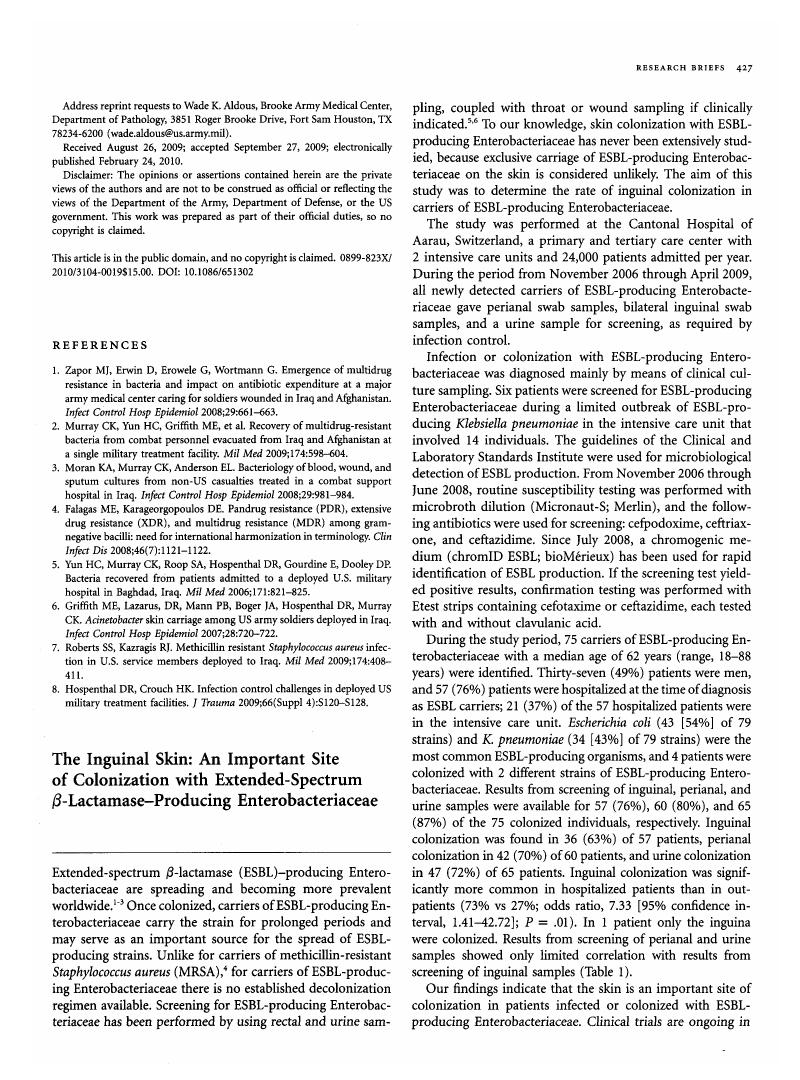Crossref Citations
This article has been cited by the following publications. This list is generated based on data provided by Crossref.
Conrad, Christian
2010.
„Natürlicher Verlauf der Kolonisation mit gramnegativen multiresistenten Keimen bei hospitalisierten Patienten“.
Krankenhaus-Hygiene + Infektionsverhütung,
Vol. 32,
Issue. 3-4,
p.
110.
Gupta, N.
Limbago, B. M.
Patel, J. B.
and
Kallen, A. J.
2011.
Carbapenem-Resistant Enterobacteriaceae: Epidemiology and Prevention.
Clinical Infectious Diseases,
Vol. 53,
Issue. 1,
p.
60.
Snyder, Graham M.
and
D’Agata, Erika M.C.
2012.
Diagnostic accuracy of surveillance cultures to detect gastrointestinal colonization with multidrug-resistant gram-negative bacteria.
American Journal of Infection Control,
Vol. 40,
Issue. 5,
p.
474.
Tzouvelekis, L. S.
Markogiannakis, A.
Psichogiou, M.
Tassios, P. T.
and
Daikos, G. L.
2012.
Carbapenemases in Klebsiella pneumoniae and Other Enterobacteriaceae: an Evolving Crisis of Global Dimensions.
Clinical Microbiology Reviews,
Vol. 25,
Issue. 4,
p.
682.
Huttner, B.
Haustein, T.
Uckay, I.
Renzi, G.
Stewardson, A.
Schaerrer, D.
Agostinho, A.
Andremont, A.
Schrenzel, J.
Pittet, D.
and
Harbarth, S.
2013.
Decolonization of intestinal carriage of extended-spectrum -lactamase-producing Enterobacteriaceae with oral colistin and neomycin: a randomized, double-blind, placebo-controlled trial.
Journal of Antimicrobial Chemotherapy,
Thurlow, Caroline J.
Prabaker, Kavitha
Lin, Michael Y.
Lolans, Karen
Weinstein, Robert A.
and
Hayden, Mary K.
2013.
Anatomic Sites of Patent Colonization and Environmental Contamination with Klebsiella pneumoniae Carbapenemase—Producing Enterobacteriaceae at Long-Term Acute Care Hospitals.
Infection Control & Hospital Epidemiology,
Vol. 34,
Issue. 1,
p.
56.
van der Boon, Robert M.A.
Nuis, Rutger-Jan
Benitez, Luis M.
Van Mieghem, Nicolas M.
Perez, Sergio
Cruz, Lidsa
van Geuns, Robert-Jan
Serruys, Patrick W.
van Domburg, Ron T.
Dager, Antonio E.
and
de Jaegere, Peter P.T.
2013.
Frequency, Determinants and Prognostic Implications of Infectious Complications After Transcatheter Aortic Valve Implantation.
The American Journal of Cardiology,
Vol. 112,
Issue. 1,
p.
104.
Ruscher, Claudia
Pfeifer, Yvonne
Layer, Franziska
Schaumann, Reiner
Levin, Katja
and
Mielke, Martin
2014.
Inguinal skin colonization with multidrug-resistant bacteria among residents of elderly care facilities: Frequency, persistence, molecular analysis and clinical impact.
International Journal of Medical Microbiology,
Vol. 304,
Issue. 8,
p.
1123.
Tacconelli, E.
Cataldo, M.A.
Dancer, S.J.
De Angelis, G.
Falcone, M.
Frank, U.
Kahlmeter, G.
Pan, A.
Petrosillo, N.
Rodríguez-Baño, J.
Singh, N.
Venditti, M.
Yokoe, D.S.
and
Cookson, B.
2014.
ESCMID guidelines for the management of the infection control measures to reduce transmission of multidrug-resistant Gram-negative bacteria in hospitalized patients.
Clinical Microbiology and Infection,
Vol. 20,
Issue. ,
p.
1.
Cassir, N.
Papazian, L.
Fournier, P.-E.
Raoult, D.
and
La Scola, B.
2015.
Insights into bacterial colonization of intensive care patients’ skin: the effect of chlorhexidine daily bathing.
European Journal of Clinical Microbiology & Infectious Diseases,
Vol. 34,
Issue. 5,
p.
999.
Stier, C.J.N.
Paganini, M.C.
de Souza, H.H.M.
Costa, L.M.D.
dos Santos, G.S.
and
Cruz, E.D.A.
2016.
Active surveillance cultures: comparison of inguinal and rectal sites for detection of multidrug-resistant bacteria.
Journal of Hospital Infection,
Vol. 92,
Issue. 2,
p.
178.
Reuben, Jacqueline
Donegan, Nancy
Wortmann, Glenn
DeBiasi, Roberta
Song, Xiaoyan
Kumar, Princy
McFadden, Mary
Clagon, Sylvia
Mirdamadi, Janet
White, Diane
Harris, Jo Ellen
Browne, Angella
Hooker, Jane
Yochelson, Michael
Walker, Milena
Little, Gary
Jernigan, Gail
Hansen, Kathleen
Dockery, Brenda
Sinatro, Brendan
Blaylock, Morris
Harmon, Kimary
Iyengar, Preetha
Wagner, Trevor
and
Nelson, Jo Anne
2017.
Healthcare Antibiotic Resistance Prevalence – DC (HARP-DC): A Regional Prevalence Assessment of Carbapenem-Resistant Enterobacteriaceae (CRE) in Healthcare Facilities in Washington, District of Columbia.
Infection Control & Hospital Epidemiology,
Vol. 38,
Issue. 8,
p.
921.
Kim, Sun Ah
Kang, Nayeon
and
Park, Taesung
2022.
Hierarchical Structured Component Analysis for Microbiome Data Using Taxonomy Assignments.
IEEE/ACM Transactions on Computational Biology and Bioinformatics,
Vol. 19,
Issue. 3,
p.
1302.
Bauer, Jules
Robineau, Olivier
Sobocinski, Jonathan
D’Elia, Piervito
Boucher, Anne
Lafon-Desmurs, Barthelemy
Tetart, Macha
Meybeck, Agnes
Patoz, Pierre
and
Senneville, Eric
2024.
Enterococcus-related vascular graft infection: A case series.
Infectious Diseases Now,
Vol. 54,
Issue. 6,
p.
104940.



